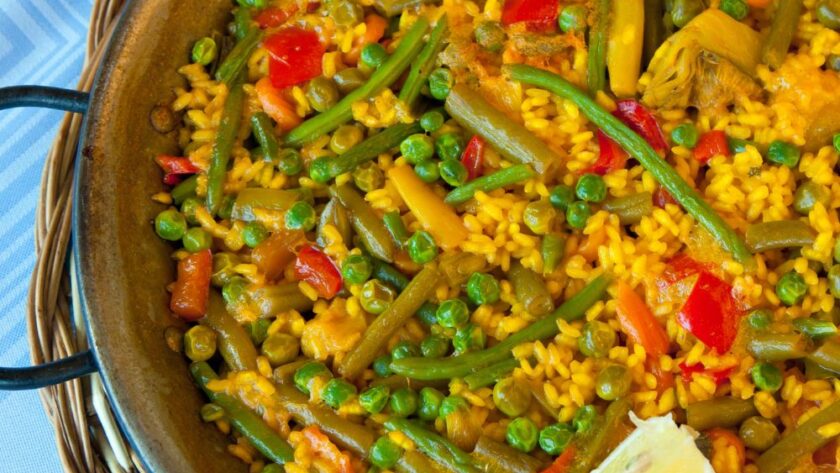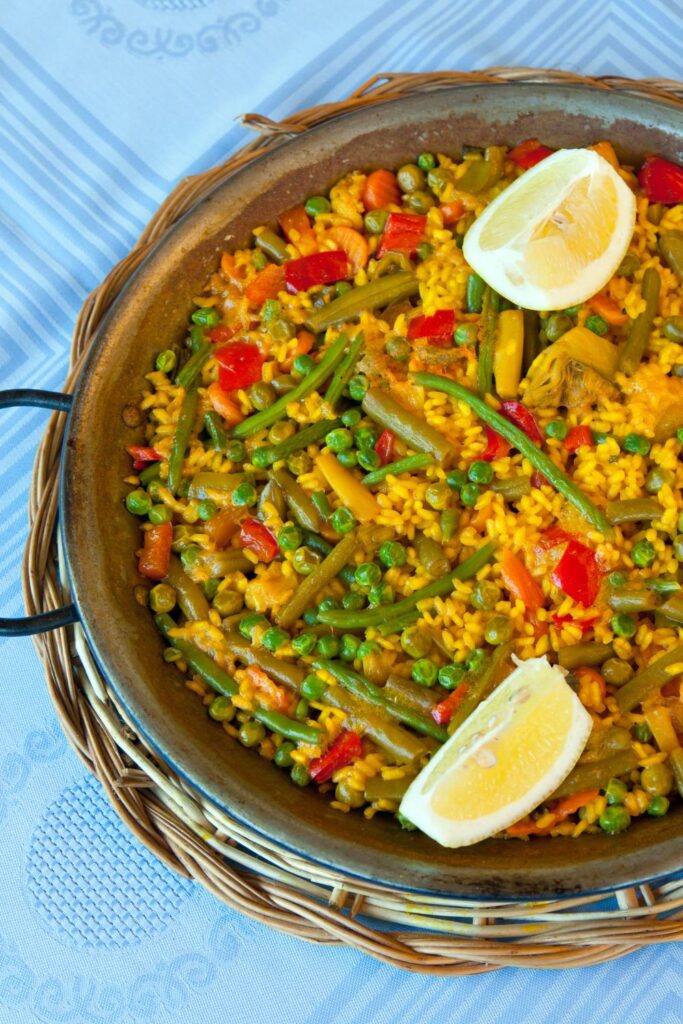This dish—Jamie Oliver Vegetarian Paella—hit me like a surprise hug. The kind that catches you off guard, warm and earthy and exactly what you didn’t know you needed. Sweet carrots, smoky paprika, and a pinch of saffron that blooms into something almost floral, like the air after summer rain. I made this on a rainy Sunday, when I needed comfort but didn’t want heavy. This gave me exactly that. Inspired by Jamie Oliver.
Ingredients Needed
- 3 tablespoons olive oil, the good stuff
Veg Base:
- 2 carrots, chopped small enough to scoop up with a spoon
- A bunch of scallions or spring onions, sliced bluntly
- 3 garlic cloves—chopped fine, sharp-smelling and potent
Grains & Flavor:
- 2 cups short-grain rice (don’t grab long grain—it just doesn’t work the same)
- 1 cup sofrito, deep and jammy if you can make it homemade
- 1½ teaspoons smoked paprika, the red kind that smells like campfires
- ½ teaspoon saffron threads, crumbled between your fingers like old paper
Vegetables:
- 3 cups of whatever is fresh, bright, and makes you happy:
- asparagus
- peas
- cherry tomatoes
- summer squash
- baby artichokes if you’re feeling fancy
- even a rogue radish or two
Liquid & Toppings:
- 5 cups vegetable broth, hot and ready
- And for the end:
- Lemon wedges
- Olives (briny ones)
- Toasted almond slices
How To Make Jamie Oliver Vegetarian Paella
- Oven goes on—300°F. Get your big skillet out. I use one that’s beat up and perfect. Eleven inches across, give or take.
- Start with oil. Let it shimmer, then throw in scallions. Stir ’til they slump. In go the carrots. Stir more. The smell will start to shift, something sweet and vegetal. Add garlic—watch your timing here. Burnt garlic ruins everything.
- Toss in the rice. Stir like you mean it, get each grain slicked up. Don’t walk away. Wait until the rice turns a little glassy, like sea glass. Then: sofrito. Paprika. Saffron. It all goes in now. The color deepens. It starts to smell like something you’d pay for.
- Add the veg. Stir them in with care. Now, pour in the hot broth. Steam hits your face. It’s a moment.
- Let it all simmer. Not bubbling like mad—more like gentle conversation. Stir just a little. Then stop. Really. Let it be. That’s how the bottom crust, the socarrat, forms. Leave it alone for 17 minutes.
- Taste the broth. Salt if it needs it. Then pop the whole thing in the oven. Twelve minutes. Just enough time to clean up or open a bottle of wine.
- Back out it comes. Want that bottom extra crispy? Throw it on the stove for a minute or two. Watch it. Listen for that crackle. Don’t let it burn.
- Now let it rest. Don’t rush. Breathe. Then scatter those toppings. Go wild or keep it simple. Either way, serve while warm and everyone’s standing around asking what that smell is.

Why I Love This Recipe
The day I made this, it was grey. My energy was somewhere on the floor. I didn’t want to go to the shop again. Somehow, this dish made me feel like I’d done something good with the day. Maybe it was the saffron, or the way the rice soaked up everything like a memory. It felt honest. Like cooking with your hands instead of your head.
Recipe Tips
- Use Bomba rice if you can. It holds its shape, soaks up flavor like it was born for it. Arborio works, but it’s not the same.
- Always heat the broth. Cold broth shocks the rice and slows the magic. It messes with everything.
- Once the broth’s in, stop stirring. Let it be. Trust it.
- Crush saffron gently between your fingertips, like coaxing out a story it’s keeping.
- Chop your vegetables close to the same size. Not perfection, just enough to keep things even in the pan.
How To Store This Jamie Oliver Vegetarian Paella
- At Room Temperature: Cool it fully. Don’t leave it hanging out more than a couple hours. Not worth the risk.
- In the Fridge: Stick it in an airtight container. It’ll keep for three days or so. Still good the next day, just different.
- In the Freezer: Honestly, Don’t. Rice goes weird. Mushy. Sad.
Reheating:
- Oven: Low and slow—300°F. Ten to fifteen minutes. Covered loosely.
- Microwave: If you must. One to two minutes, stir halfway.
- Stovetop: My favorite. A skillet, a splash of broth, medium heat. Stir gently.
Let’s Answer a Few Questions!
What pan should I use for paella?
Wide and shallow is the goal. Doesn’t have to be a “paella” pan. Just don’t go deep.
What is sofrito and where do I get it?
It’s that deep, rich tomato-garlic-onion mix. Like the soul of the dish. Find it in jars—or better yet, make it. It’s worth it.
Can I make this ahead?
Prep ahead, sure. Cook it fresh though. Reheated paella just isn’t the same. You’ll see.
Is there a saffron substitute?
Turmeric for color, maybe. But saffron’s like poetry. Hard to fake.
How do I know when it’s done?
The rice is tender, not mush. Most of the broth should be gone. Too wet? Cook a little longer, crank the heat.
Nutrition Facts (per serving)
- Calories: 234
- Carbs: 42g
- Protein: 5.5g
- Fat: 4.8g
- Sugar: 5.4g
- Fibre: 3.3g
- Sodium: 6mg
Try More Recipes:
- Savory Homemade Corned Beef Hash
- Jamie Oliver Steak And Mushroom Pie
- Jamie Oliver Bacon Tomato Pasta
Jamie Oliver Vegetarian Paella
Course: DinnerCuisine: British4
servings15
minutes30
minutes234
kcalA vibrant, cozy vegetarian paella with bold spices and tender veggies—comforting, colorful, and perfect for sharing straight from the pan.
Ingredients
3 tbsp olive oil
2 carrots, diced
1 bunch scallions, chopped
3 garlic cloves, chopped
1 cup sofrito
1.5 tsp smoked paprika
0.5 tsp saffron threads, crushed
3 cups mixed vegetables
5 cups hot vegetable broth
Toppings: lemon, olives, almonds, herbs
Directions
- Rest a bit, then garnish and serve.
- Preheat oven to 300°F. Heat oil in skillet.
- Sauté onions and carrots. Add garlic.
- Stir in rice, sofrito, paprika, saffron.
- Add vegetables and broth. Simmer gently.
- Simmer 17 mins, then bake 12 mins.
- Optional: Crisp the bottom 1-2 mins on stovetop.
Notes
- Use Bomba rice if you can. It holds its shape, soaks up flavor like it was born for it. Arborio works, but it’s not the same.
- Always heat the broth. Cold broth shocks the rice and slows the magic. It messes with everything.
- Once the broth’s in, stop stirring. Let it be. Trust it.
- Once the broth’s in, stop stirring. Let it be. Trust it.
- Crush saffron gently between your fingertips, like coaxing out a story it’s keeping.
- Chop your vegetables close to the same size. Not perfection, just enough to keep things even in the pan.

